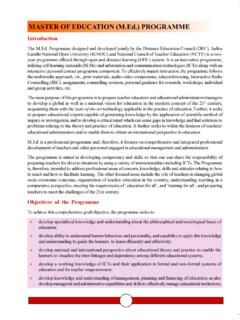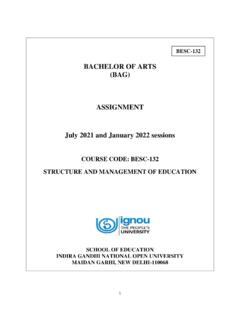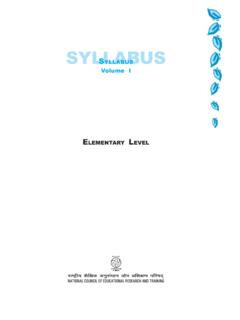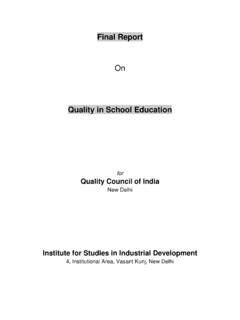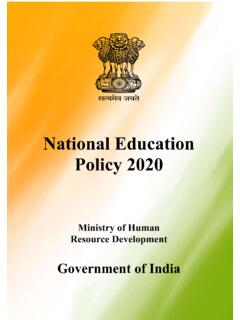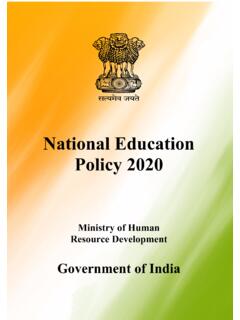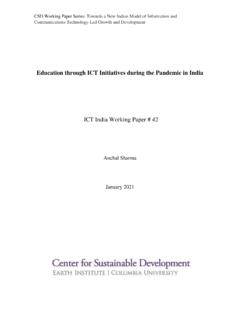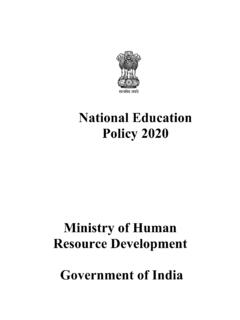Transcription of Gender Concerns in Education
1 1 Structure of the Module Overview Introduction Objectives Strategies for Enhancing Girls Participation at Secondary Level: Textbooks and Gender Teaching and Learning Processes Hidden curriculum Classroom Organization and Management Assessment Concluding Remarks References Gender Concerns in Education Prof. Gouri Srivastava Head Department of Gender Studies, NCERT Overview I am uncompromising in the matter of Women s rights. In my opinion she should labour under no legal disability not suffered by men. I should treat the daughters and sons on a footing of perfect equality. Mahatma Gandhi, Young india , 17-10 29 Gender is a social construct that impacts attitudes, roles, responsibilities and behavior patterns of boys and girls, men and women in all societies.
2 Gender relations vary from society to society. It is a women s and people s issues shaped by power relations in multicultural societies like india . It deals with human Concerns encompassing diversities and differences. It has been the most endemic form of discrimination operating across cultures in developed and developing societies. When one analyses the present context of Gender discourses, the prime concern is how Gender functions as a determinant of politics of knowledge production. Education has the inbuilt potential of initiating social change in the context of Gender relations. Therefore, conscious and pluralistic interventions have been put forward by the Government of india to address Gender equality in Education at the 2 centre and state level.
3 A landmark initiative was undertaken in 1986, with the enactment of the National Policy on Education (NPE) and its revised POA 1992. This philosophy has also been reflected in the National Policy on Empowerment of Women 2001. The policy focuses on promoting Gender sensitive curriculum for addressing Gender discrimination at all levels of Education . The new draft of National Policy lays emphasizes on Encourage, Educate and Employ , all irrespective of their socio-economic background. Gender Concerns in Education have also been reflected in curriculum frameworks developed by apex national organization like National Council of Educational Research and Training (NCERT). In this regard curriculum frameworks of 1975, 1988, 2000 and 2005 have made specific efforts to focus attention on Gender disparities in Education .
4 The journey has been from concern to substantial inclusion. While a lot of efforts have been made on integrating Gender Concerns in Education ; globalization, liberalization and expansion in information technology have once again made it mandatory for revisiting Gender Concerns in Education in a proactive manner as an important developmental agenda. There is now an emerging need to reflect and focus in a proactive manner on transforming attitudes, beliefs and behavioral patterns that impact Gender relation in family, community, school and work place and so on. Gender debates and discourses have to be operationalised within the overarching concern for democratizing Education . In this context, constitutional commitments, policy initiatives, schemes and programmes have been conceptualized by Centre and State Governments at different points of time to address Gender barriers in Education .
5 The recent promising initiative is the Rashtriya Madhyamik Shiksha Abhiyan (RMSA) that attempts to universalize Education at the secondary level. This programme began in 2009. RMSA focuses on secondary Education . This stage of Education encompasses critical mass of children between the age group of 14-18 years. This stage of Education serves as a bridge between elementary and higher Education . It is the twilight years of adolescence. in india , adolescence constitute about one fifth of the population. This large and increasing share of adolescent and youth in india need to be provided with quality Education that promotes empowerment, skills and employability. To address this concern, RMSA programmes envisages an enrolment rate of 75% from in 2005-06 at secondary stage.
6 The other objectives include improving quality of 3 Education imparted at secondary level through making all secondary school conform to prescribed norms, remove Gender , socio-economic and disability barriers. Important equity interventions provided in the scheme are special focus on micro planning, preference to areas with concentration of SC/ ST/ Minority for opening of schools, special enrolment drive for weaker section, more female teachers in schools and separate toilet blocks for girls. In the present module, an attempt has been made for sensitizing, RMSA functionaries, teacher-educators and teachers on making textbooks and pedagogical processes Gender inclusive. 1. 2 Introduction The genesis of RMSA can be traced to the Secondary Education Commission (1952-53) that focuses on development of democratic citizenship, improvement of vocational efficiency, promotion of leadership and development of personality.
7 The significance of this stage of Education was touched upon by the National Policy on Education 1986. The policy mentions Secondary Education begins to expose students to the differentiated roles of science, the humanities and social sciences. This is also an appropriate stage to provide children with a sense of history and national perspective and give them opportunities to understand their constitutional duties and rights as citizens. Conscious internalization of a healthy work ethos and of the values of a humane and composite culture will be brought about through appropriately formulates curricula (Experts from National Policy on Education (1986). In the context of Gender , this policy mentions that sex stereo-typing in vocational and professional courses will be eliminated and women s participation in non-traditional occupations, and emergent technologies would be encouraged.)
8 The CABE Committee on Universalisation of Secondary Education (2005) stated that high quality secondary Education would be provided to all adolescent girls and boys up to the age of 16 by 2015 and up to the age of 18 by 2020. The National Curriculum Framework 2005 also mentions that secondary school is period of intense physical change and formations of identity. It is also the period of intense vibrancy and energy. The ability for abstract reasoning and logical thinking emerges, allowing children the possibility of deep engagement with both understanding and generating knowledge beyond here and now. A critical understanding of the self in relation to society also emerges during this period.
9 4 In order to translate the policy statement into practice, the RMSA Scheme not only lays thrust on universalization of secondary Education for Classes IX and X, but makes a specific mention of addressing Gender disparities in Education and promoting Education of girls from varying socio-economic backgrounds. The focus of RMSA is also gear towards making specific reforms in teaching and learning process and in all those related activities that would make the schooling ethos inclusive in all aspects. Objectives: To familiarize RMSA functionaries on equity interventions provided in the Scheme with a focus on girls To identify Gender bias and stereotypes in textual materials To encourage teachers to adopt participatory approaches in the teaching and learning process To make classroom environment Gender inclusive Strategies for Enhancing Girls Participation at Secondary Level: The enrolment scenario of girls at secondary stage of Education is mentioned in Table 1.
10 Table1: Gross Enrolment Ratios All Categories Years Class VI-VIII (11-13 Years) Class IX-X (14-15 Years) Class XI-XII (16-17 Years) Boys Girls Boys Girls Boys Girls 2006-07 2007-08 2008-09 2009-10 2010-11 Scheduled Castes 2006-07 2007-08 2008-09 2009-10 2010-11 Scheduled Tribes 2006-07 2007-08 2008-09 2009-10 2010-11 Source: Statistics of School Education , MHRD, GOI, New Delhi. Various years reports 5 Activities Collect information regarding enrolment of girl s Education at secondary stage in your block/district/state. Identify reasons for lack of participation of girls at secondary stage.










